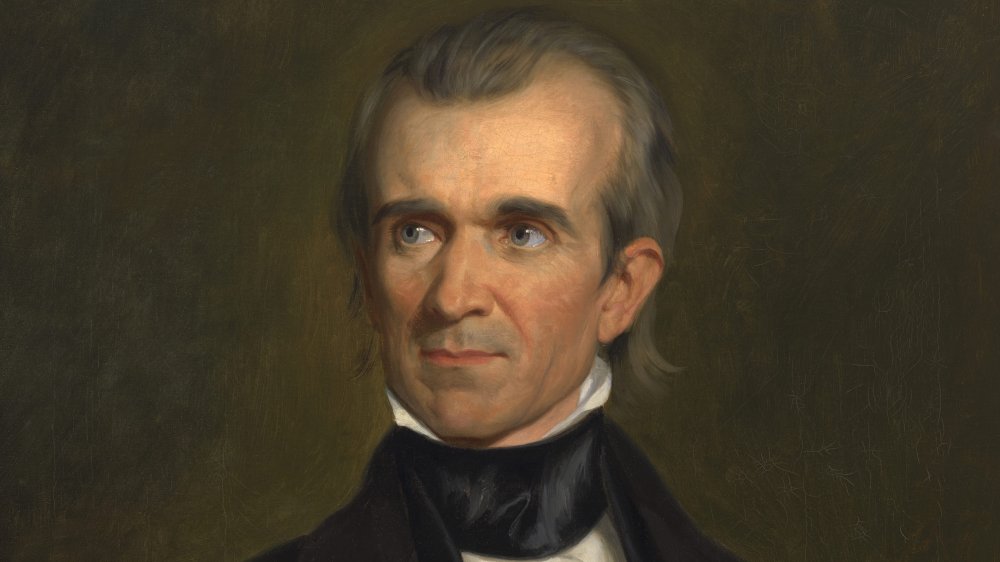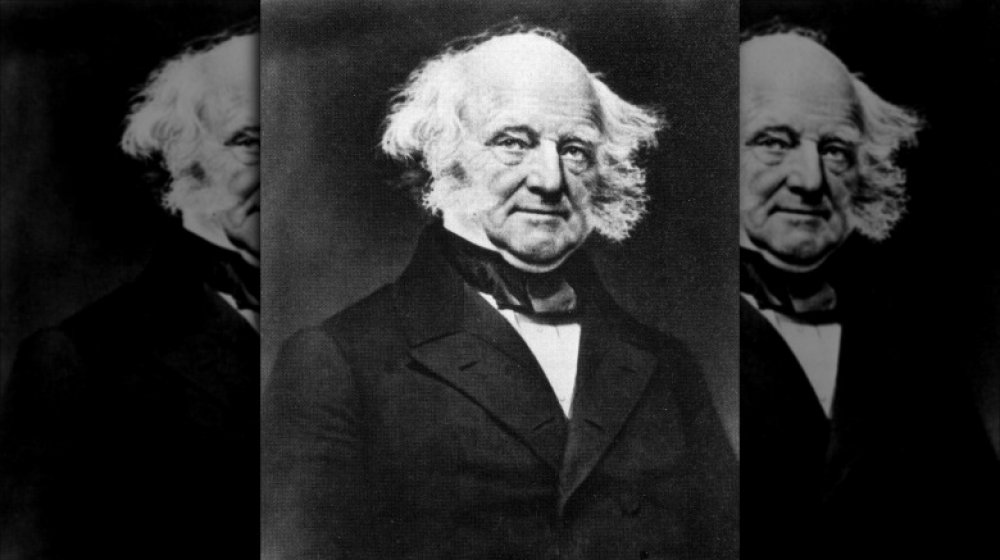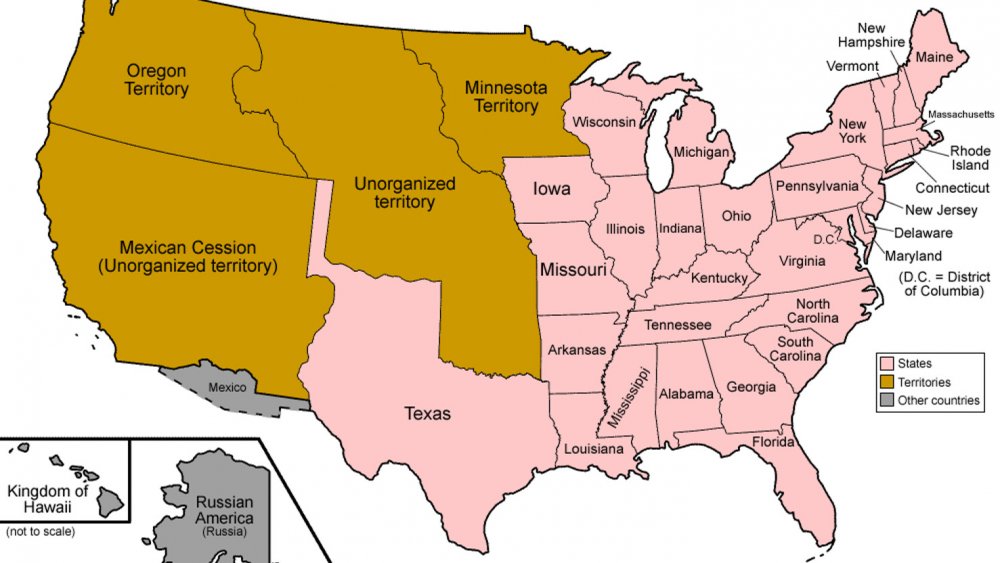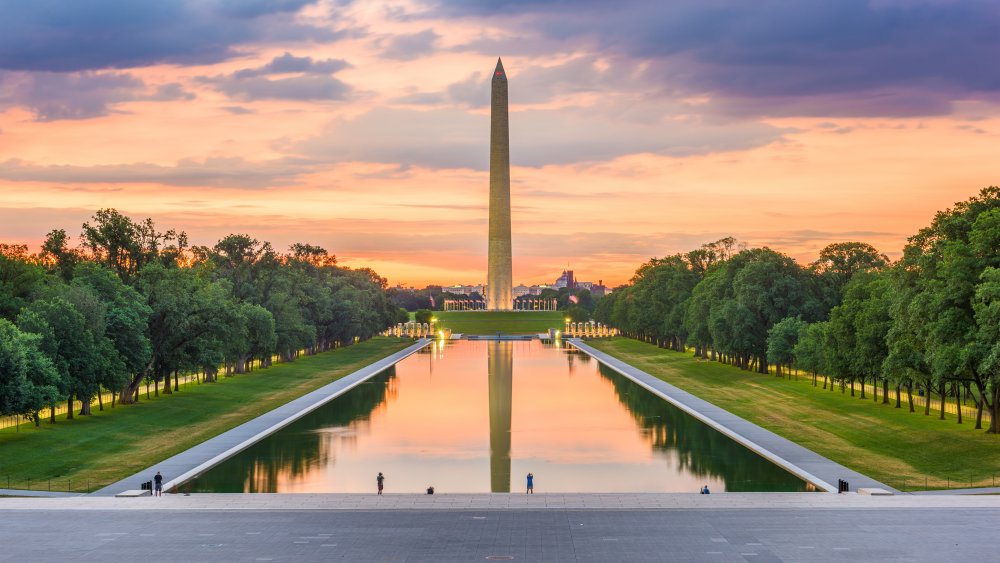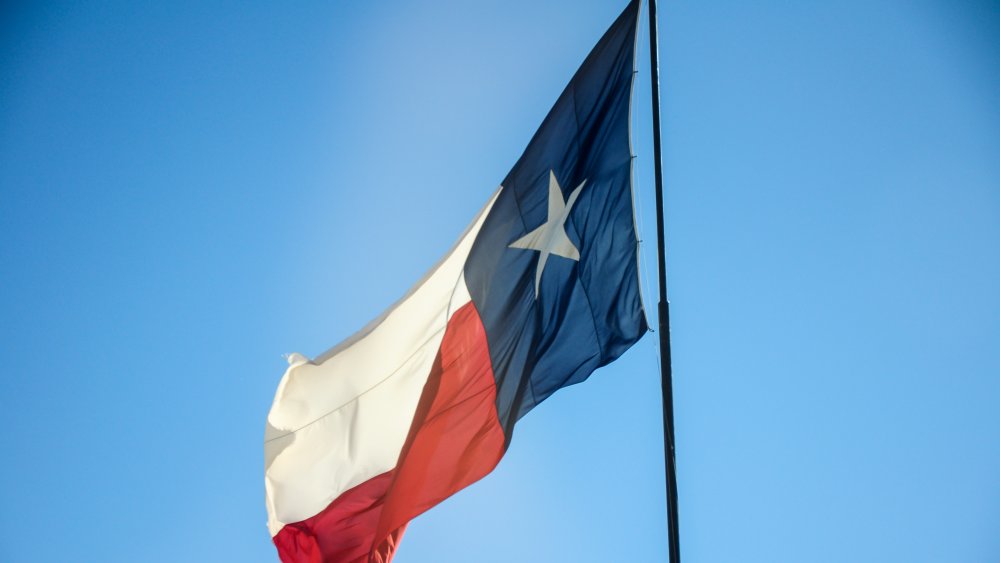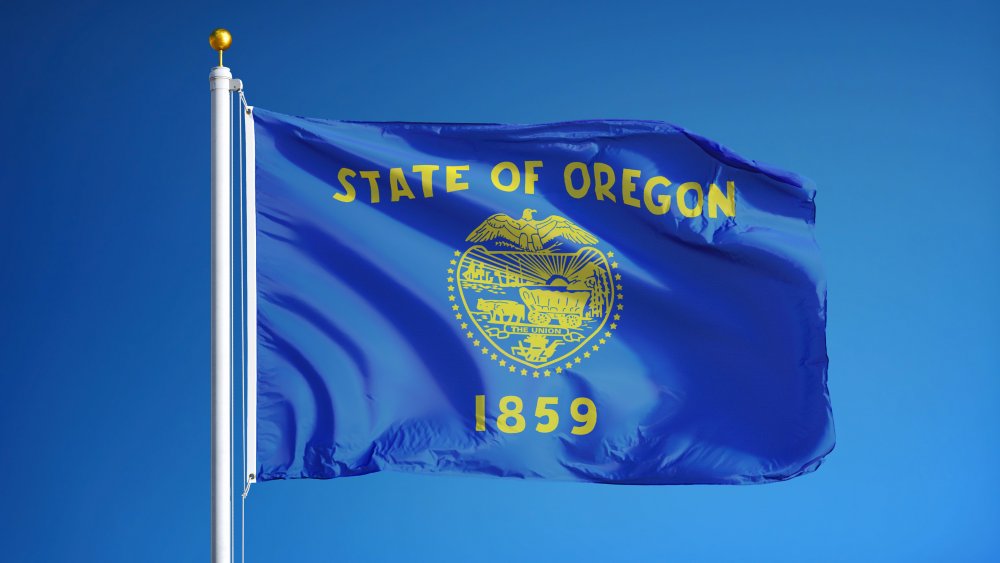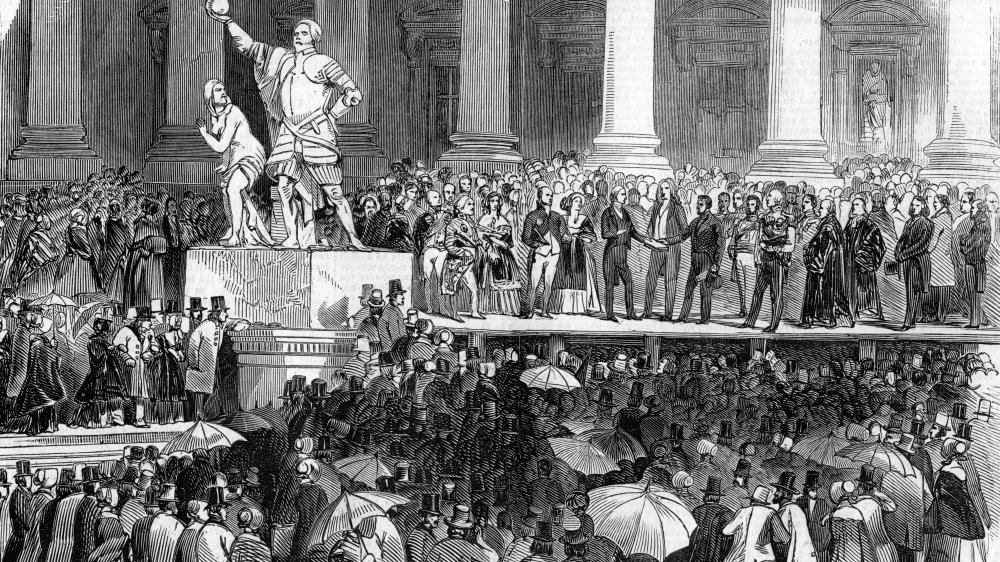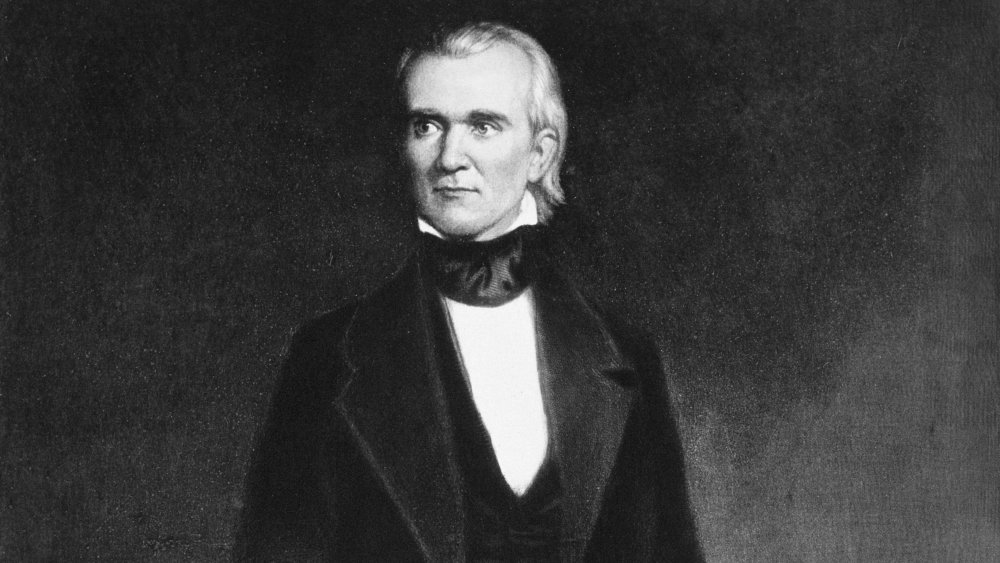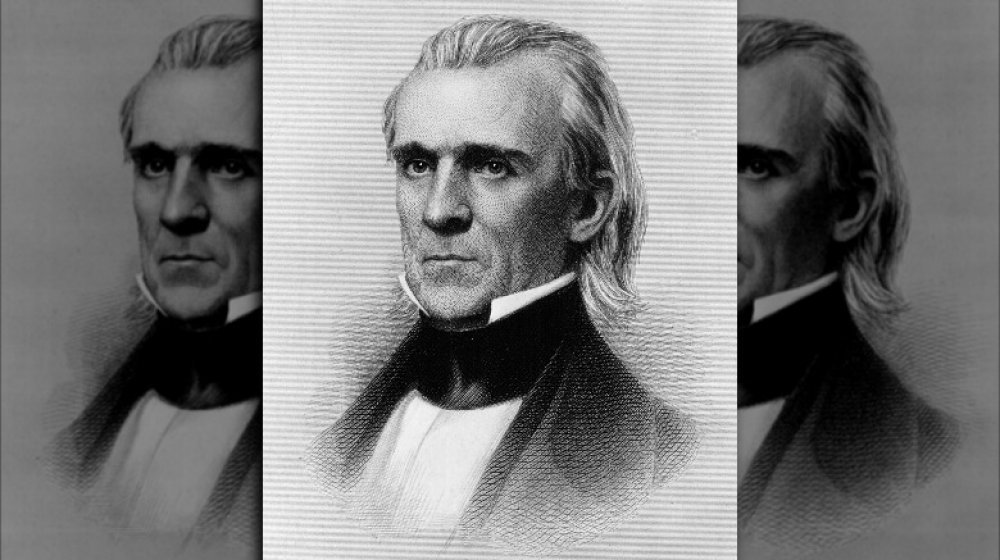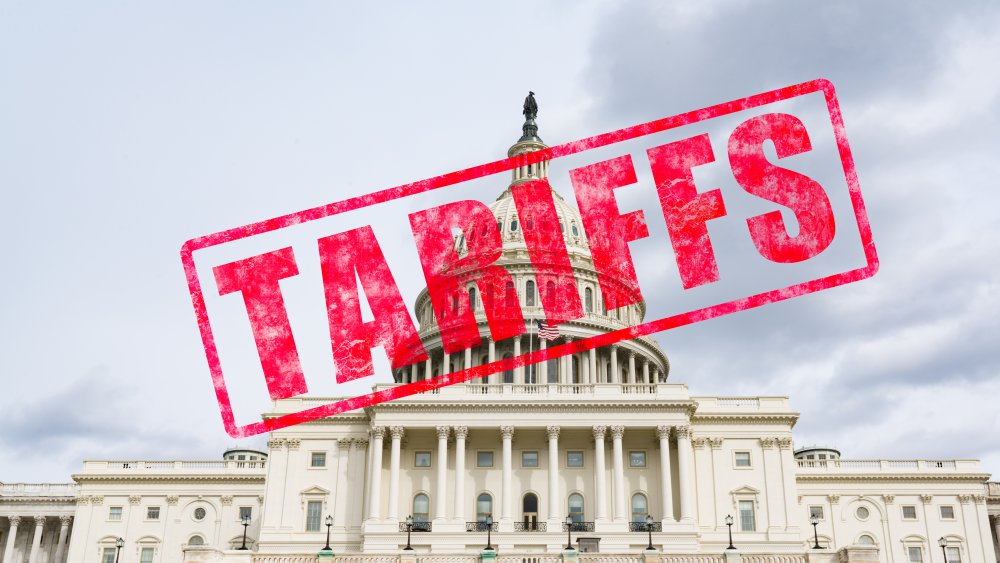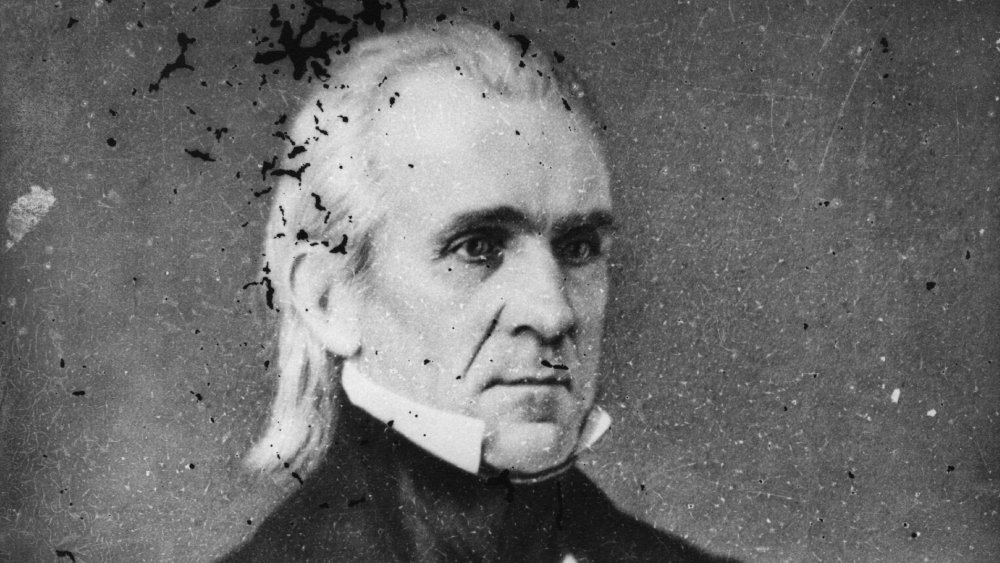Why James Polk Was The Most Underrated President
Americans love to rank things. This is largely due to our unshakable belief that we're generally #1 in everything, but it also reflects a desire to better understand our history. Sifting something like our presidents into the best, the pretty good, and the terrible is a useful exercise for informing our future decisions, after all.
That ranking shifts over time. On the one hand, a president's performance is sometimes overshadowed by events or personal characteristics. On the other, as attitudes and politics change over time, a president's reputation can change in hindsight — and it can often take decades or even centuries for the decisions of a specific administration to show their true repercussions.
As we curate and revise our list of the best presidents in history, a few dark horses emerge as surprising choices. Perhaps the most surprising is James K. Polk, who served as our 11th president from 1845 to 1849. He's such a dark horse many people forget he was president at all — but there are a surprising number of reasons why Polk was the most underrated president in US history.
James Polk defied the political odds
American politics has always been a little crazy, and making predictions about who will be president is a great way to look very dumb. And no one looked dumber than pretty much the entire country in 1844, when just about everyone assumed that Martin Van Buren, our eighth president, would be elected for a second (non-consecutive) term.
As History.com reports, James Polk was relatively unknown at the time. He'd served as a representative in congress and as governor of Tennessee, but back in the days before the Internet (or even television), that meant he wasn't well-known outside his own state. He was also hella young for a president at the time — at just 49, he would be the youngest president to serve up to that point.
But Polk was a smart politician, and he read the mood of the nation better than his rivals. President John Tyler had managed to annex Texas just a few months before the election, and the issue of whether to let this expansion of the US stand was a hot issue. Polk came down hard in support of making Texas the newest state in the union, while his rivals were mixed on the issue. That proved to be decisive — and Polk's political acumen brought him the White House.
James Polk expanded the country
If you measure a president by the force of their convictions and how well they apply them to policy, James Polk was one of the most successful presidents in history. Unfortunately, one of the key convictions Polk held was that the United States — that is, white folks relatively recently arrived from Europe — not only had the right to claim every bit of land between the oceans regardless of who might already live there but were literally destined to do so.
Manifest destiny, the belief that white Americans would be a Christian, "civilizing" force that should sweep indigenous Americans aside, was an explicitly racist and imperialist concept. It was also one of James Polk's driving ambitions, and as History Today notes, it made his administration one of the most effective in US history. As a result of his commitment to this policy of expansion that disregarded the rights of millions of people, Polk expanded the United States dramatically. He solidified the annexation of Texas, took a huge swath of land from Mexico after winning the Mexican-American War, and claimed another enormous chunk of land from Great Britain when he negotiated for possession of the Oregon Territory. If you look at a map of the US before Polk's presidency and a map after he left office, his achievements are very clear — even if the morality of those achievements was dubious at best.
James Polk oversaw the Washington Monument and created the Smithsonian
As every American knows, in politics, there's often a lot of daylight between the stuff politicians say they will do and the stuff they actually do. One of the earliest examples is pretty hard to ignore: the Washington Monument.
As The Washington Post notes, Congress declared their intention to create a monument to George Washington a few days after our first president passed away in 1799. But more than three decades later, almost no work had gone into the monument. It wasn't until James Polk was president in 1845 that a design and location were finally approved and construction of the obelisk began. Polk didn't have much to do directly with the monument, but his administration oversaw making it a reality.
As History.com notes, James Smithson died in 1829, and in his will, he left his fortune and collection of scientific notes and exhibits to his nephew — but stipulated that his money should go to the United States in order to found an institution celebrating knowledge if his nephew died without heirs. Six years later, that's what happened, and President Andrew Jackson sent diplomats to England to claim Smithson's bequest. But it wasn't until 1846 that President James Polk finally signed legislation establishing the Smithsonian Institution. After nearly 20 years, James Polk got it done.
James Polk won the Mexican-American War
James Polk was a Southerner, a slave owner, and an imperialist — but he was a very effective chief executive. Texas had been annexed by the United States under President John Tyler, but it was Polk who guided it to becoming the 28th state of the union. Texas' statehood was controversial because everyone expected Mexico to declare war if the US claimed it and because anti-slavery factions were worried that it would become a slave state.
As History.com reports, Mexico didn't immediately declare war, and Polk offered Mexico $20 million to settle the disputed border between Texas and Mexico and purchase what would eventually become the Southwest United States. Mexico refused this offer, and Polk ordered troops to the border. In May 1846, Polk insisted that Mexico had killed US troops in a brief conflict and asked Congress to declare war, which it did.
Polk's leadership was decisive in the conflict. He wanted an aggressive campaign, and that's what Generals Zachary Taylor and Winfield Scott gave him, eventually defeating the larger Mexican army and capturing Mexico City. In the peace treaty that followed, Polk took a hard line and got everything he'd asked — for just $15 million. As the Encyclopedia Britannica notes, all of this new territory exacerbated the slavery issue and almost led to a civil war until the Compromise of 1850 made peace again, but there's little doubt that the Mexican-American War and Polk's leadership expanded the US and doomed it to eventually split apart.
James Polk acquired the Oregon Territory diplomatically
If James Polk used war to expand the US into Texas and the Southwest, he used diplomacy to expand it into the Oregon Territory and the Northwest. Not only that, but he did so by negotiating a deal with Great Britain that left everyone happy.
As Smithsonian Education explains, the area of the country that is present-day Washington, Oregon, and Idaho (and portions of other states) had been variously claimed by the British, the Russians, and the Spanish. By the early 1800s, however, the United States and the British were the only claimants left standing, and in 1818, they negotiated a joint occupation. Over the years, more Americans settled in the area, making Great Britain think it best if they got the heck out.
Polk had made settling the Oregon Territory in America's favor a plank of his election campaign. As the Miller Center notes, Polk was an expert negotiator, initially asking for an ambitious border that went up to the 54th parallel (in what is present-day Canada), knowing full well he would accept less. His strategy worked, with the US eventually settling on the 49th parallel. Everyone walked away from the negotiating table feeling like they'd gotten what they wanted — with the notable exception of the indigenous people, who weren't even consulted.
James Polk achieved every one of his goals
Every president enters office with a platform, a list of things they intend to tackle while they hold the reins of power. Most presidents are lucky to achieve a few of their main goals. Politics and reality usually get in the way because presidents aren't autocrats — they have a very limited ability to simply order things into being. President Polk is often underrated because we don't appreciate how effective he was.
As History.com notes, James Polk was a rarity: He had a very concise and very clear agenda when he entered office. Polk outlined four major things he wanted to tackle: cut tariffs in order to stimulate trade (especially with the United Kingdom), establish an independent US Treasury, negotiate sole ownership of the Oregon Territory, and settle the Southwest, making Texas a state and acquiring and the territories of California and New Mexico.
As noted in The Washington Post, Polk accomplished every single one of his goals in just four years. By the time he left office in 1849, he'd acquired the Oregon and Southwestern territories, settled Texas and the border between it and Mexico, established the independent treasury, and opened up trade. Polk was a uniquely focused and talented man whose accomplishments aren't the sexiest — but they're incredibly impressive nonetheless.
James Polk promised to serve just one term — and he kept his promise
Candidates for president have occasionally offered up a "one term pledge" as a way of mollifying their opponents. These pledges are usually regarded as gimmicks — once in the White House, it's pretty easy to imagine dozens of reasons way they simply have no choice but to renege.
So when James Polk announced in 1844 that if elected, he would only serve one term, it was natural to be suspicious. As The New York Times notes, while Polk was known to be averse to lengthy terms for presidents, there was also a practical reason he made his pledge: He needed the power brokers of the party to unite behind him, and he knew they had their doubts about him. By promising to serve just one term, he reassured them that they wouldn't have to put up with him for too long.
Then, as History.com notes, Polk enjoyed an incredibly successful term in which he achieved everything he'd set out to do. While he had his share of controversy — the Mexican-American War became very unpopular as it dragged on, he got close to war with Britain over the Oregon Territory, and his slave-owning ways made a large part of the country suspicious of him — he certainly had an argument to make that he deserved a second term.
But he kept his promise. He didn't run a campaign in 1848, and when his term ended, he packed up and went home.
James Polk reformed our financial system
When James Polk took office in 1845, the United States' finances were a mess. While there had been a central, independent treasury before, the laws had been changed and the federal government was depositing its money in state banks and investments across the country. This made managing the nation's money chaotic and less effective than it should have been. According to History.com, one of Polk's main goals when running for president was the establishment of an independent treasury. He wanted the government to put its money in its own vaults and control how it was invested.
As noted by historian Walter R. Borneman, Polk got to work immediately and, by 1846, had legislation through the House of Representatives that would establish an independent treasury. The bill then died in the Senate, and Polk had to use his powers of persuasion to prompt senators to finally push it out of committee. When it was finally voted on, Polk got his party to line up behind it, and the bill passed by a vote of 28-25.
James Polk changed how the US did business forever. The United States never went back to the old system of local banks. The Polk-Walker bill of 1846 remained in effect until 1913, when the Federal Reserve System was created to take its place.
James Polk expanded the authority of the presidency
The United States was born out of a revolution, and the Founding Fathers were deeply suspicious of executive power. As a result, the government they initially designed (the Articles of Confederation) was so weak and ineffectual that it came close to collapsing. The one they designed to replace it, our current system, beefed up federal authority, but they still envisioned the president as limited by the separation of powers.
That being said, the history of American government is, in many ways, a history of the steady expansion of the president's powers — and James Polk was a key player. As historian Walter R. Borneman notes, Polk expanded his authority via the simple expedient of actually using his powers without apology or hesitation. He invoked his wartime powers aggressively and established a hands-on managerial style in the executive branch, increasing his influence and power as a result. As Borneman puts it, Polk ended his tenure as president as the "most assertive chief executive prior to Abraham Lincoln."
When people complain today that the president has too much power and can do too much with executive orders that bypass Congress and "police actions" that allow them to wage war without declaring it officially, you can trace it back to Polk and his muscular expansion of the chief executive's powers. Whether that's a good thing or not is up for debate — but Polk's presidency was transformative.
The Panama Canal wouldn't exist without James Polk
The decisions made by presidents can have a long-ranging influence on history. Sometimes it takes decades for the chain of events set in motion by a president to become clear. Such is the case with the Panama Canal. Although construction on the canal didn't begin until the 1880s and wasn't completed until 1914, it probably wouldn't exist at all if James Polk hadn't been president.
The Miller Center explains in 1846, while the US was embroiled in the Mexican-American War, Polk worried that Great Britain might take advantage of the confusion by being more aggressive in the Caribbean and Central America. When New Granada (present-day Colombia) suggested a treaty, Polk was enthusiastic. Part of the treaty included language that guaranteed the sovereignty of New Granada — and the neutrality of the isthmus that linked North and South America.
Six decades later, Panama was fighting for independence, and President Theodore Roosevelt used that treaty as an excuse to get involved and support its cause. This, in turn, made it possible for the US to complete the canal and control the most important piece of real estate in the Western Hemisphere for a century. Polk probably couldn't see that far into the future, but he knew a god deal when he saw one.
James Polk freed up trade
One of James Polk's main goals upon taking office was to improve commercial relations with Great Britain. As historian Walter R. Borneman notes, in the days before income taxes, tariffs were a key source of income for the US, and in 1845, the country had a very high tariff in place that kept trade between the US and the UK to a minimum.
Polk worked closely with Secretary of the Treasury Robert J. Walker to craft the Walker Tariff. This law set the tariff rate independent of the value of the products being imported, and it effectively lowered the tariff rates from 32 to 25 percent. That might seem like a small change, but it made all the difference in the world — it was, at the time, the lowest tariff rate in United States history. As the Encyclopedia Britannica notes, it also had the effect of improving diplomatic relations with Great Britain.
Polk then worked hard to push the tariff through Congress, even going so far as to send men to retrieve a recalcitrant senator from the train station in order to persuade him in person. In the end, the Senate tied on the vote, and Polk forced his vice president, George Dallas, to vote in favor — much to Dallas' chagrin. The tariff has been described as a "free trade" tariff due to its low rates and led to a boom in trade, just as Polk had wanted.
James Polk established the United States as a world power
Presidential legacies can be difficult to pin down. The passage of time and changing attitudes have a tendency to shift perspectives. But one thing is clear about James Polk: He took charge of a country that was a regional power and set it on the path to becoming the world power it is today through a series of consequential decisions.
As historian David M. Pletcher writes, Polk's savvy decision to pursue a treaty with New Granada (present-day Colombia) not only made the Panama Canal possible 60 years later but was a crucial step in transforming the US into a world power. It extended the United States' influence into South America and established our young country as a player on the world stage.
Even more important, as historian Amy S. Greenberg notes, is the Mexican-American War. That war had immediate positive outcomes for the US in terms of territory gained and the demonstration of military might. It also had some longer-term negative impacts, as all that new territory exacerbated the frictions between abolitionists and slave owners in the US, setting the stage for the Civil War. But it also served to prove that the US was no longer the feeble regional power that the British had pushed around during the War of 1812 but a world power ready and willing to flex its economic, military, and diplomatic might. President James Polk put the US on the path to power.
